Related Research Articles
Spirit possession is an unusual or an altered state of consciousness and associated behaviors which are purportedly caused by the control of a human body and its functions by spirits, ghosts, demons, angels, or gods. The concept of spirit possession exists in many cultures and religions, including Buddhism, Christianity, Haitian Vodou, Dominican 21 Divisions, Hinduism, Islam, Wicca, and Southeast Asian, African, and Native American traditions. Depending on the cultural context in which it is found, possession may be considered voluntary or involuntary and may be considered to have beneficial or detrimental effects on the host. Spirit possession is often regarded as a reason in support of spirits, deities or demons. In a 1969 study funded by the National Institute of Mental Health, spirit possession beliefs were found to exist in 74% of a sample of 488 societies in all parts of the world, with the highest numbers of believing societies in Pacific cultures and the lowest incidence among Native Americans of both North and South America. As Pentecostal and Charismatic Christian churches move into both African and Oceanic areas, a merger of belief can take place, with demons becoming representative of the "old" indigenous religions, which the Christian ministers attempt to exorcise.

The Exorcist is a 1971 horror novel written by American writer William Peter Blatty and published by Harper & Row. The book details the demonic possession of eleven-year-old Regan MacNeil, the daughter of a famous actress, and the two priests who attempt to exorcise the demon. The novel was the basis of a highly successful film adaptation released two years later, whose screenplay was also written and produced by Blatty. More movies and books were eventually added to The Exorcist franchise.
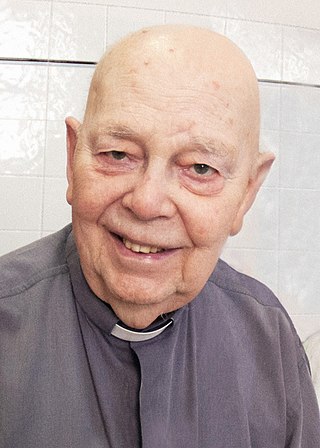
Gabriele Amorth was an Italian Catholic priest of the Paulines and an exorcist for the Diocese of Rome. Amorth, along with five other priests, founded the International Association of Exorcists.
Walter H. HalloranSJ was a Catholic priest of the Society of Jesus who, at the age of twenty-six, assisted in the exorcism of Roland Doe, a thirteen-year-old Lutheran boy in Cottage City, Maryland, who was allegedly possessed. The case inspired William Peter Blatty to write his novel The Exorcist.

William S. Bowdern was a Catholic priest of the Society of Jesus in St. Louis, Missouri. He was the author of The Problems of Courtship and Marriage printed by Our Sunday Visitor in 1939. He was a graduate of and taught at St. Louis University High School; he also taught at St. Louis University.
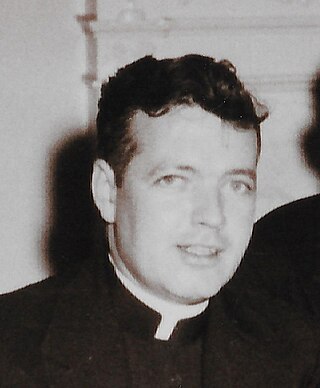
Father Edward Albert Hughes was a Roman Catholic priest who served as an assistant pastor from June 16, 1948 to June 18, 1960 at St. James Church in Mt. Rainier, Maryland. He was best known for his participation in the Exorcism of Roland Doe.
Raymond J. Bishop was a Catholic priest who was one of the several involved in the case of exorcising a boy in Maryland, who allegedly was possessed after using a ouija board. The case inspired author William Peter Blatty to write his 1971 novel The Exorcist.
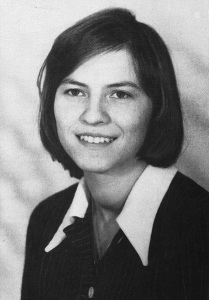
Anna Elisabeth "Anneliese" Michel was a German woman who underwent 67 Catholic exorcism rites during the year before her death. She died of malnutrition, for which her parents and priest were convicted of negligent homicide. She was diagnosed with epileptic psychosis and had a history of psychiatric treatment that proved ineffective.

Possessed is a 2000 American horror television film directed by Steven E. de Souza, written by de Souza and Michael Lazarou, and starring Timothy Dalton. The film is based on events appearing in the 1993 book Possessed by Thomas B. Allen, which was inspired by the exorcism case of Roland Doe.

Exorcism is the religious or spiritual practice of evicting demons, jinns, or other malevolent spiritual entities from a person, or an area, that is believed to be possessed. Depending on the spiritual beliefs of the exorcist, this may be done by causing the entity to swear an oath, performing an elaborate ritual, or simply by commanding it to depart in the name of a higher power. The practice is ancient and part of the belief system of many cultures and religions.

Father Damien "Demis" Karras, SJ, is a fictional character from the 1971 novel The Exorcist, its 1983 sequel Legion, one of the main protagonists in the 1973 film The Exorcist, and a supporting character in The Exorcist III, the 1990 film adaptation of Legion. He is portrayed by Jason Miller.
Thomas Benton Allen was an American author and historian. He resided in Bethesda, Maryland. He was also the father of science fiction writer Roger MacBride Allen. Allen was a contributing editor to National Geographic. Allen had co-authored numerous books with Norman Polmar. He had also written numerous mystery novels.

Pazuzu is a fictional character who is the main antagonist in The Exorcist horror novels and film series, created by William Peter Blatty. Blatty derived the character from Assyrian and Babylonian mythology, where the mythic Pazuzu was considered the king of the demons of the wind, and the son of the god Hanbi. In The Exorcist, Pazuzu appears as a demon who possesses Regan MacNeil.

The Rite is a 2011 supernatural horror film directed by Mikael Håfström and written by Michael Petroni. It is loosely based on Matt Baglio's book The Rite: The Making of a Modern Exorcist, which itself is based on actual events as witnessed and recounted by American then-exorcist-in-training Father Gary Thomas and his experiences of being sent to Rome to be trained and work daily with veteran clergy of the practice.
Clara Germana Cele was a South African Christian girl, who in 1906, was said to be possessed by a demon.
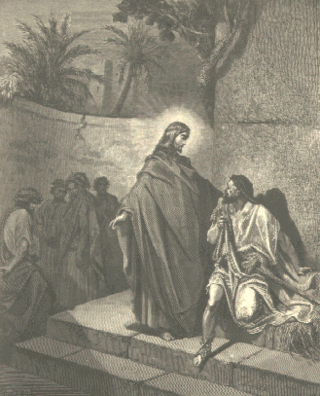
In Christianity, exorcism involves the practice of casting out one or more demons from a person whom they are believed to have possessed. The person performing the exorcism, known as an exorcist, is often a member of the Christian Church, or an individual thought to be graced with special powers or skills. The exorcist may use prayers and religious material, such as set formulas, gestures, symbols, icons, or amulets. The exorcist often invokes God, Jesus, angels and archangels, and various saints to aid with the exorcism. Christian exorcists most commonly cast out demons in Jesus' name.
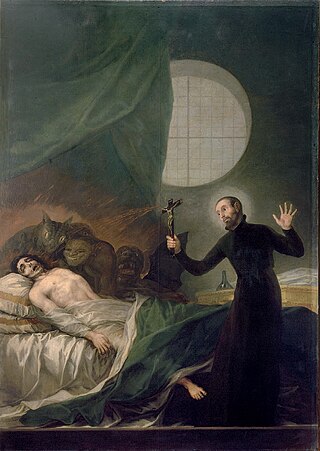
The Catholic Church authorizes the use of exorcism for those who are believed to be the victims of demonic possession. In Roman Catholicism, exorcism is a sacramental but not a sacrament, unlike baptism or confession. Unlike a sacrament, exorcism's "integrity and efficacy do not depend ... on the rigid use of an unchanging formula or on the ordered sequence of prescribed actions. Its efficacy depends on two elements: authorization from valid and licit Church authorities, and the faith of the exorcist." The Catechism of the Catholic Church states: "When the Church asks publicly and authoritatively in the name of Jesus Christ that a person or object be protected against the power of the Evil One and withdrawn from his dominion, it is called exorcism."

The Exorcist is an American horror media franchise that originated with William Peter Blatty's 1971 horror novel of the same name and most prominently featured in a 1973 film adaptation of the novel, and many subsequent prequels and sequels. All of these installments focus on fictional accounts of people possessed by Pazuzu, the main antagonist of the series, and the efforts of religious authorities to counter this possession.

Thomas Valentine Bermingham, SJ was an American Jesuit priest, and Classical teacher and scholar. In addition to his academic career at institutions including Fordham University and Georgetown University, he was known for his involvement in the production of the 1973 horror film The Exorcist, on which he worked as a technical advisor as well as acting in a minor role.
The Ammons haunting case, also known as the 200 Demons House or Demon House, is an alleged haunting and demonic possession which occurred in Gary, Indiana, in the United States in 2011. Latoya Ammons, her mother, Rosa Campbell, and her three children claimed paranormal activity occurred in the residence. The story was publicized in January 2014 and received national attention.
References
- 1 2 3 4 5 6 7 Opasnick, Mark. "The Cold Hard Facts Behind the Story that Inspired "The Exorcist"". Strange Magazine #20. Retrieved 7 November 2015.
- ↑ JD Sword (November 2021). "Demoniac: Who Is Roland Doe, the Boy Who Inspired The Exorcist?". Skeptical Inquirer. Vol. 45, no. 6.
- ↑ Maya Yang (2021-12-20). "Boy whose case inspired The Exorcist is named by US magazine". The Guardian.
- ↑ Lockhart, Douglas (June 1999). The dark side of God: a quest for the lost heart of Christianity. New York City: Element Books / Houghton Mifflin. p. 101. ISBN 978-1-86204-458-6 . Retrieved April 3, 2010.
- ↑ Scher Zagier, Alan (October 30, 2013). "Exorcism of 1949 continues to fascinate St. Louis". News Union . Grass Valley, California: Swift Communications . Retrieved June 28, 2018.
- 1 2 3 4 Thomas B. Allen (11 November 2013), Possessed: The True Story of an Exorcism, BookCountry, ISBN 978-1-4630-0367-8
- ↑ Garland, Amy (Spring 2014). "Exorcism Exposé: An in-depth look at Saint Louis University's part in the most famous exorcism of the 20th century". Universitas. Vol. 40, no. 2. Saint Louis University. pp. 13–15. Retrieved 14 October 2023. PDF
- 1 2 3 4 5 "Jesuit Priest Walter Halloran". The Washington Post. Associated Press. 9 March 2005. p. B6. Retrieved 2007-12-31.
- ↑ Drabelle, Dennis (12 July 1993). "The Demon Within: Was It . . . Satan?". The Washington Post (Book review). Archived from the original on 2015-09-24.
Allen is careful to delineate the symptoms of possession, thus softening the blow when, at the end of the book, he offers the consensus of today's experts: Robbie was just a deeply disturbed boy, nothing supernatural about him.
- 1 2 3 Nickell, Joe (January 2001). "Exorcism! Driving Out the Nonsense". Skeptical Inquirer. Committee for Skeptical Inquiry. Retrieved 16 October 2023.
- ↑ Cooper, Terry D.; Epperson, Cindy K. (2008-09-02). Evil: Satan, Sin, and Psychology. Paulist Press. p. 22. ISBN 978-0-8091-4536-2 . Retrieved 14 October 2023.
- 1 2 Cinema of the occult: new age, satanism, Wicca, and spiritualism in film. Rosemont Publishing & Printing Corp. 2008-12-31. ISBN 9780934223959 . Retrieved 2010-04-04.
- ↑ Vanderpool, Charles (director) (1997). In the Grip of Evil.
- ↑ Christopher Saint Booth & Philip Adrian Booth (directors) (1 October 2010). The Haunted Boy: The Secret Diary of the Exorcist (Video 2010).